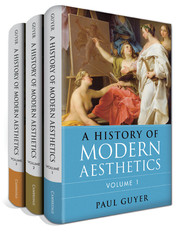Book contents
- Volume 1 The Eighteenth Century
- Volume 2 The Nineteenth Century
- Volume 3 The Twentieth Century
- Frontmatter
- Contents
- Acknowledgments
- Introduction
- Part One German Aesthetics in the Twentieth Century
- Part Two Aesthetics in Britain until World War II
- Part Three American Aesthetics in the First Half of the Twentieth Century
- Part Four Wittgenstein and After
- 11 Wittgenstein
- 12 The First Wave
- 13 The Second Wave
- Epilogue Truth, Feeling, and Play in Recent Aesthetics
- Bibliography
- References
Epilogue - Truth, Feeling, and Play in Recent Aesthetics
from Part Four - Wittgenstein and After
Published online by Cambridge University Press: 05 June 2015
- Volume 1 The Eighteenth Century
- Volume 2 The Nineteenth Century
- Volume 3 The Twentieth Century
- Frontmatter
- Contents
- Acknowledgments
- Introduction
- Part One German Aesthetics in the Twentieth Century
- Part Two Aesthetics in Britain until World War II
- Part Three American Aesthetics in the First Half of the Twentieth Century
- Part Four Wittgenstein and After
- 11 Wittgenstein
- 12 The First Wave
- 13 The Second Wave
- Epilogue Truth, Feeling, and Play in Recent Aesthetics
- Bibliography
- References
Summary
As we have seen throughout this study, the field of aesthetics has been a scene of intense activity since the beginning of the eighteenth century. The decades immediately surrounding the turn of the twenty-first century have been no exception. It is too soon to attempt to summarize the rich variety of work that has been done in these years, on old and new artistic media, at the intersections of aesthetics and other disciplines, such as philosophy of language, cognitive science, and more. In this conclusion, I will merely illustrate the riches of contemporary aesthetics by discussing a few areas of recent work that bear on the central theme of this study, the relations among the idea of the cognitive import of aesthetic experience, its emotional impact, and its analysis as the free play of the imagination.
Playing with Emotions
Walton
I begin with the idea of play and its connections to both cognition and emotion. In spite of the large output of scholarship on Kant’s aesthetic theory that began in the 1970s and has only accelerated in recent years, with one exception the concept of play has not figured centrally in recent aesthetic theory. The notable exception to this statement has been the work of Kendall Walton (born 1939), professor throughout his career at the University of Michigan. Walton’s 1990 book Mimesis and Make-Believe abjured any ambition of offering a general theory of either art or aesthetic experience (Walton completed his Ph.D. at Cornell in 1967, when Cornell was certainly one of the hotbeds of Wittgensteinianism in the United States) but proposed to construct a general theory of fictional representation on an idea of playing games of make-believe based on children’s play. Although Walton makes no mention of this fact, his project of offering a detailed analysis of the experience of fiction as a form of play, which traces both similarities and differences between this form of play and child’s play but also between this form of play and dreams, is in the tradition of his University of Michigan predecessor DeWitt Parker.
- Type
- Chapter
- Information
- A History of Modern Aesthetics , pp. 557 - 604Publisher: Cambridge University PressPrint publication year: 2014



